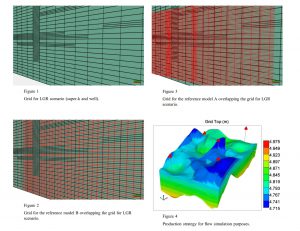Flow Simulation Using Local Grid Refinements to Model Laminated Reservoirs
Super-giant carbonate fields, such as Ghawar, in Saudi Arabia, and Lula, at the Brazilian pre-salt, show highly heterogeneous behavior that is linked to high permeability intervals in thin layers. This article applies Local Grid Refinements (LGR) integrated with upscaling procedures to improve the representation of highly laminated reservoirs in flow simulation by preserving the static properties and dynamic trends from geological model. This work was developed in five main steps: (1) define a conventional coarse grid, (2) define LGR in the conventional coarse grid according to super-k and well locations, (3) apply an upscaling procedure for all scenarios, (4) define LGR directly in the simulation model, without integrate geological trends in LGR and (5) compare the dynamic response for all cases. To check results and compare upscaling matches, was used the benchmark model UNISIM-II-R, a refined model based on a combination of Brazilian Pre-salt and Ghawar field information. The main results show that the upscaling of geological models for coarse grid with LGR in highly permeable thin layers provides a close dynamic representation of geological characterization compared to conventional coarse grid and LGR only near-wells. Pseudo-relative permeability curves should be considered for (a) conventional coarse grid or (b) LGR scenarios under dual-medium flow simulations as the upscaling of discrete fracture networks and dual-medium flow models presents several limitations. The conventional approach of LGR directly in simulation model, presents worse results than LGR integrated with upscaling procedures as the extrapolation of dynamic properties to the coarse block mismatch the dynamic behavior from geological characterization. This work suggests further improvements for results for upscaling procedures that mask the flow behavior in highly laminated reservoirs.


